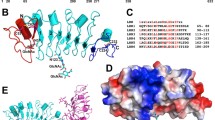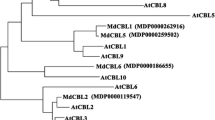Abstract
We previously characterized LePRK1 and LePRK2, pollen-specific receptor kinases from tomato (Muschietti et al., 1998). Here we identify a similar receptor kinase from maize, ZmPRK1, that is also specifically expressed late in pollen development, and a third pollen receptor kinase from tomato, LePRK3. LePRK3 is less similar to LePRK1 and LePRK2 than either is to each other. We used immunolocalization to show that all three LePRKs localize to the pollen tube wall, in partially overlapping but distinct patterns. We used RT-PCR and degenerate primers to clone homologues of the tomato kinases from other Solanaceae. We deduced features diagnostic of pollen receptor kinases and used these criteria to identify family members in the Arabidopsis database. RT-PCR confirmed pollen expression for five of these Arabidopsis candidates; two of these are clearly homologues of LePRK3. Our results reveal the existence of a distinct pollen-specific receptor kinase gene family whose members are likely to be involved in perceiving extracellular cues during pollen tube growth.
Similar content being viewed by others
References
Altschul, S.F., Madden, T.L. Schäffer, A.A., Zhang, J., Zhang, Z., Miller, W. and Kipman, D.J. 1997. Gapped BLAST and PSI-Blast: a new generation of protein database search programs. Nucl. Acids Res. 25: 3389–3402.
Arabidopsis Genome Initiative. 2000. Analysis of the genome sequence of the flowering plant Arabidopsis thaliana. Nature 408: 796–815.
Carpenter, J.M. 1988. Choosing among equally parsimonious cladograms. Cladistics 4: 291–296.
Dellaporta, S.L., Wood, J. and Hicks, J.B. 1983. A plant DNA mini-preparation: version II. Plant Mol. Biol. Rep. 1: 19–21.
Du, L. and Chen, Z. 2000. Identification of genes encoding receptor-like protein kinases as possible targets of pathogen-and salicylic acid-induced WRKY DNA-binding proteins in Arabidopsis. Plant J. 24: 837–847.
Farris, J.S. 1969. A successive approximations approach to character weighting. Syst. Zool. 18: 374–385.
Feijo, J., Sainhas, J., Holdaway-Clarke, T., Cordeiro, M., Kunkel, J. and Hepler, P. 2001. Cellular oscillations and the regulation of growth: the pollen tube paradigm. BioEssays 23: 86–94.
Felsenstein, J. 1985. Confidence limits on phylogenies: an approach using the bootstrap. Evolution 39: 783–791.
He, Y. and Wetzstein, H.Y. 1995. Fixation induces differential tip morphology and immunolocalization of the cytoskeleton in pollen tubes. Physiol. Plant. 93: 757–763.
He, Z., Wang, Z.Y., Li, J., Zhu, Q., Lamb, C., Ronald, P. and Chory, J. 2000. Perception of brassinosteroids by the extracellular domain of the receptor kinase BRI1. Science 288: 2360–2363.
Jahnen, W., Lush, W.M. and Clarke, A.E. 1989. Inhibition of in vitro pollen tube growth by isolated S-glycoproteins of Nicotiana alata. Plant Cell 1: 501–510.
Jinn, T, Stone, J. and Walker, J. 2000. HAESA, an Arabidopsis leucine-rich repeat receptor kinase, controls floral organ abscission. Genes Dev. 11: 108–117.
Kajava, A.V. 1998. Structural diversity of leucine-rich repeat proteins. J. Mol. Biol. 277: 519–527.
Kawagoe, Y. and Kikuta, Y. 1991. Chloroplast DNA evolution in potato (Solanum tuberosum L.). Theor. Appl. Genet. 18: 12–20.
Kim, Y.S., Jeong, H.L., Gyeong, M.Y., Cho, H.S., Park, S., Suh, M.C., Choi, D., Ha, H.J., Liu, J.R. and Pai, H.-S. 2000. CHRK1, a chitinase-related receptor-like kinase in tobacco. Plant Physiol. 123: 905–915.
Kobe B. and Deisenhofer J. 1994. The leucine-rich repeat: a versatile binding motif. Trends Biochem. Sci. 19: 415–421.
Kulikauskas, R. and McCormick, S. 1997. Identification of the tobacco and Arabidopsis homologues of the pollen-expressed LAT59 gene of tomato. Plant Mol. Biol. 34: 809–814.
Lee, H.S., Karunanandaa, B., McCubbin, A., Gilroy, S. and Kao, T.H. 1996. PRK1, a receptor-like kinase of Petunia inflata, is essential for postmeiotic development of pollen. Plant J. 9: 613–624.
Li, H., Bacic, A. and Read, S.M. 1999. Role of a callose synthase zymogen in regulating wall deposition in pollen tubes of Nicotiana alata. Planta 208: 528–538.
Li, Y., Bruun, L., Pierson, E.S. and Cresti, M. 1992. Periodic deposition of arabogalacan eptopes in the cell wall of pollen tubes of Nicotiana tabacum L. Planta 188: 5332–5338.
Lin, Y., Wang, Y., Zhu, J.-K., and Yang, Z. 1996. Localization of a Rho GTPase implies a role in tip growth and movement of the generative cell in pollen tubes. Plant Cell 8: 293–303.
Logemann, J., Schell, J. and Willmitzer, L. 1987. Improved method for the isolation of RNA from plant tissues. Anal. Biochem. 163: 16–20.
Lush,W.M. 1999. Whither chemotropism and pollen tube guidance? Trends Plant Sci. 4: 413–418.
Marshall, D.L. 1998. Pollen donor performance can be consistent across maternal plants in wild radish (Raphanus sativus, Brassicaceae): a necessary condition for the action of sexual selection. Am. J. Bot. 85: 1389–1397.
Marshall, D.L., Ellstrand, N.C., Hatfield, C. and Bennett. T. 1996. Does interference competition occur among pollen grains of wild radish? Evolution 50: 1842–1848.
Mascarenhas, J.P. 1993. Molecular mechanisms of pollen tube growth and differentiation. Plant Cell 5: 1303–1314.
McCormick, S., Smith, A., Gasser, C., Sachs, K., Hinchee, M., Horsch, R., and Fraley, R. 1987. The identification of genes specifically expressed in reproductive organs of tomato. In: D. Nevins and R. Jones (Eds.) Tomato Biotechnology, Alan R. Liss, New York, pp. 255–265.
Miller, J. C. and Tanksley, S D. 1990. RFLP analysis of phylogenetic relationships and genetic variation in the genus Lycopersicon. Theor. Appl. Genet. 80: 437–448.
Mollet, J.C., Park, S., Nothagel, E.A. and Lord, E.M. 2000. A lily stylar pectin is necessary for pollen tube adhesion to an in vitro stylar matrix. Plant Cell 12: 1737–1749.
Mu, J.H., Lee, H.S., and Kao, T.H. 1994. Characterization of a pollen-expressed receptor-like kinase gene of Petunia inflata and the activity of its encoded kinase. Plant Cell 6: 709–721.
Muschietti, J., Eyal, Y. and McCormick, S. 1998. Pollen tube localization implies a role in pollen-pistil interaction for the tomato receptor-like protein kinases LePRK1 and LePRK2. Plant Cell 10: 319–330.
Palanivelu, R. and Preuss, D. 2000. Pollen tube targeting and axon guidance: parallels in tip growth mechanisms Trends Cell Biol. 10: 517–524.
Park, S.Y., Jauh, G.Y, Mollet, J.C., Eckhard, K.J., Nothnagel, E.A., Walling, L.L. and Lord, E.M. 2000. A lipid-transfer-like protein is necessary for lily pollen tube adhesion to an in vitro stylar matrix. Plant Cell 12: 151–164.
Sambrook, J., Fritsch, E.F. and Maniatis, T. 1989. Molecular Cloning: A Laboratory Manual, 2nd ed. Cold Spring Harbor Laboratory Press, Plainview, NY.
Shiu, S.-H. and Bleecker, A.B. 2001. Receptor-like kinases from Arabidopsis form a monophyletic gene family related to animal receptor kinases. Proc. Natl. Acad. Sci. USA 98: 10763–10768.
Sommer-Knudsen, J., Lush, W.M., Bacic, A. and Clarke, A.E. 1998. Re-evaluation of the role of a transmitting tract-specific glycoprotein on pollen tube growth. Plant J. 13: 529–536.
Stepka, M., Ciampolini, F., Charzynska, M. and Cresti, M. 2000. Localization of pectins in the pollen tube wall of Ornithogalum virens L. Does the pattern of pectin distribution depend on the growth rate of the pollen tube? Planta 210: 630–635.
Swofford, D. L. 1993. PAUP Phylogenetic analysis using parsimony, Version 3.1.1. Illinois Natural History Survey, Campaign, IL.
Takahashi, T., Mu, J.-H., Gasch, A. and Chua, N.-H. 1998. Identification by PCR of receptor-like protein kinases from Arabidopsis flowers. Plant Mol. Biol. 37: 587–596.
Torii, K. 2000. Receptor kinase activation and signal transduction in plants: an emerging picture. Curr. Opin. Plant Biol. 3: 361–367.
Trotochaud, A.E., Jeong, S. and Clark, S.E. 2000. CLAVATA3, a multimeric ligand for the CLAVATA1 receptor-kinase. Science 289: 613–617.
van der Biezen, E.A. and Jones, J.D.G. 1998. Plant disease-resistance proteins and the gene-for-gene concept. Trends Biochem. Sci. 23: 454–456.
Waites, R. and Simon, R. 2000. Signaling cell fate in plant meristem: three clubs on one tousle. Cell 103: 835–838.
Wu, H.M., Wang, H. and Cheung, A.Y. 1995. A pollen tube growth stimulatory glycoprotein is deglycosylated by pollen tubes and displays a glycosylation gradient in the flower. Cell 82: 395–403.
Wu, H.M., Wong, E., Ogdahl, J. and Cheung, A.Y. 2000. A pollen tube growth-promoting arabinogalactan protein from Nicotiana alata is similar to the tobacco TTS protein. Plant J. 22: 165–176.
Zhang, R. and Walker, J.C. 1993. Structure and expression of the S locus-related genes of maize. Plant Mol. Biol. 2: 1171–1174.
Author information
Authors and Affiliations
Rights and permissions
About this article
Cite this article
Kim, H.U., Cotter, R., Johnson, S. et al. New pollen-specific receptor kinases identified in tomato, maize and Arabidopsis: the tomato kinases show overlapping but distinct localization patterns on pollen tubes. Plant Mol Biol 50, 1–16 (2002). https://doi.org/10.1023/A:1016077014583
Issue Date:
DOI: https://doi.org/10.1023/A:1016077014583




